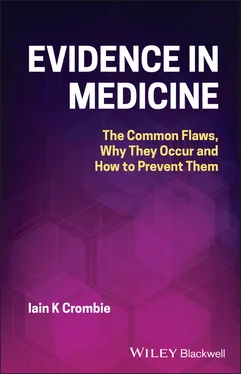29 29. van der Steen, J.T., van den Bogert, C.A., van Soest‐Poortvliet, M.C. et al. (2018). Determinants of selective reporting: a taxonomy based on content analysis of a random selection of the literature. PLoS One https://doi.org/10.1371/journal.pone.0188247.
30 30. Bello, S., Moustgaard, H., and Hrobjartsson, A. (2017). Unreported formal assessment of unblinding occurred in 4 of 10 randomized clinical trials, unreported loss of blinding in 1 of 10 trials. J. Clin. Epidemiol. 81: 42–50.
31 31. Bello, S., Moustgaard, H., and Hrobjartsson, A. (2014). The risk of unblinding was infrequently and incompletely reported in 300 randomized clinical trial publications. J. Clin. Epidemiol. 67: 1059–1069.
32 32. Yi, J., Haibo, H.L., Li, Y. et al. (2020). Risk of bias and its impact on intervention effect estimates of randomized controlled trials in endodontics. J. Endodontics 46: 12–18.
33 33. Moustgaard, H., Clayton, G.L., Jones, H.E. et al. (2020). Impact of blinding on estimated treatment effects in randomised clinical trials: meta‐epidemiological study. BMJ https://doi.org/10.1136/bmj.l6802.
34 34. Huupponen, R. and Viikari, J. (2013). Statins and the risk of developing diabetes. BMJ https://doi.org/10.1136/bmj.f3156.
35 35. Tang, E., Ravaud, P., Riveros, C. et al. (2015). Comparison of serious adverse events posted at http://ClinicalTrials.govand published in corresponding journal articles. BMC Med. https://doi.org/10.1186/s12916‐015‐0430‐4.
36 36. Favier, R. and Crepin, S. (2018). The reporting of harms in publications on randomized controlled trials funded by the “Programme Hospitalier de Recherche Clinique,” a French academic funding scheme. Clin. Trials 15: 257–267.
37 37. Hughes, S., Cohen, D., and Jaggi, R. (2014). Differences in reporting serious adverse events in industry sponsored clinical trial registries and journal articles on antidepressant and antipsychotic drugs: a cross‐sectional study. BMJ Open https://doi.org/10.1136/bmjopen‐2014‐005535.
38 38. Golder, S., Loke, Y.K., Wright, K. et al. (2016). Reporting of adverse events in published and unpublished studies of health care interventions: a systematic review. PLoS Med. https://doi.org/10.1371/journal.pmed.1002127.
39 39. Hodkinson, A., Kirkham, J.J., Tudur‐Smith, C. et al. (2013). Reporting of harms data in RCTs: a systematic review of empirical assessments against the CONSORT harms extension. BMJ Open https://doi.org/10.1136/bmjopen‐2013‐003436.
40 40. Fewtrell, M.S., Kennedy, K., Singhal, A. et al. (2008). How much loss to follow‐up is acceptable in long‐term randomised trials and prospective studies? Arch. Dis. Child. 93: 458–461.
41 41. Schulz, K.F. and Grimes, D.A. (2002). Sample size slippages in randomised trials: exclusions and the lost and wayward. Lancet 359: 781–785.
42 42. Akl, E.A., Briel, M., You, J.J. et al. (2012). Potential impact on estimated treatment effects of information lost to follow‐up in randomised controlled trials (LOST‐IT): systematic review. BMJ https://doi.org/10.1136/bmj.e2809.
43 43. Zhang, Y., Florez, I.D., Colunga Lozano, L.E. et al. (2017). A systematic survey on reporting and methods for handling missing participant data for continuous outcomes in randomized controlled trials. J. Clin. Epidemiol. 88: 57–66.
44 44. Nuesch, E., Trelle, S., Reichenbach, S. et al. (2009). The effects of excluding patients from the analysis in randomised controlled trials: meta‐epidemiological study. BMJ https://doi.org/10.1136/bmj.b3244.
45 45. Bell, M.L., Fiero, M., Horton, N.J. et al. (2014). Handling missing data in RCTs; a review of the top medical journals. BMC Med. Res. Methodol. https://doi.org/10.1186/1471‐2288‐14‐118.
46 46. Walters, S.J., Bonacho Dos Anjos Henriques‐Cadby, I., Bortolami, O. et al. (2017). Recruitment and retention of participants in randomised controlled trials: a review of trials funded and published by the United Kingdom Health Technology Assessment Programme. BMJ Open https://doi.org/10.1136/bmjopen‐2016‐015276.
47 47. Hussain, J.A., White, I.R., Langan, D. et al. (2016). Missing data in randomized controlled trials testing palliative interventions pose a significant risk of bias and loss of power: a systematic review and meta‐analyses. J. Clin. Epidemiol. 74: 57–65.
48 48. Ibrahim, F., Tom, B.D., Scott, D.L. et al. (2016). A systematic review of randomised controlled trials in rheumatoid arthritis: the reporting and handling of missing data in composite outcomes. Trials https://doi.org/10.1186/s13063‐016‐1402‐5.
49 49. Miller, B.M. and Brennan, L. (2015). Measuring and reporting attrition from obesity treatment programs: a call to action! Obes. Res. Clin. Pract. 9: 187–202.
50 50. Marciniak, T.A., Cherepanov, V., Golukhova, E. et al. (2016). Drug discontinuation and follow‐up rates in oral antithrombotic trials. JAMA Intern. Med. 176: 257–259.
51 51. Hussain, J.A., Bland, M., Langan, D. et al. (2017). Quality of missing data reporting and handling in palliative care trials demonstrates that further development of the CONSORT statement is required: a systematic review. J. Clin. Epidemiol. 88: 81–91.
52 52. White, I.R., Horton, N.J., Carpenter, J. et al. (2011). Strategy for intention to treat analysis in randomised trials with missing outcome data. BMJ https://doi.org/10.1136/bmj.d40.
53 53. Joseph, R., Sim, J., Ogollah, R. et al. (2015). A systematic review finds variable use of the intention‐to‐treat principle in musculoskeletal randomized controlled trials with missing data. J. Clin. Epidemiol. 68: 15–24.
54 54. Kahale, L.A., Diab, B., Khamis, A.M. et al. (2019). Potentially missing data are considerably more frequent than definitely missing data: a methodological survey of 638 randomized controlled trials. J. Clin. Epidemiol. 106: 18–31.
55 55. Altman, D.G. (2009). Missing outcomes in randomized trials: addressing the dilemma. Open Med. 3: 51–53.
56 56. Molnar, F.J., Hutton, B., and Fergusson, D. (2008). Does analysis using “last observation carried forward” introduce bias in dementia research? CMAJ 179: 751–753.
57 57. Lachin, J.M. (2016). Fallacies of last observation carried forward analyses. Clin. Trials 13: 161–168.
58 58. Lee, K.J. and Simpson, J.A. (2014). Introduction to multiple imputation for dealing with missing data. Respirology 19: 162–167.
59 59. Jakobsen, J.C., Gluud, C., Wetterslev, J. et al. (2017). When and how should multiple imputation be used for handling missing data in randomised clinical trials – a practical guide with flowcharts. BMC Med. Res. Methodol. https://doi.org/10.1186/s12874‐017‐0442‐1.
60 60. Donders, A.R., van der Heijden, G.J., Stijnen, T. et al. (2006). Review: a gentle introduction to imputation of missing values. J. Clin. Epidemiol. 59: 1087–1091.
61 61. Montedori, A., Bonacini, M.I., Casazza, G. et al. (2011). Modified versus standard intention‐to‐treat reporting: are there differences in methodological quality, sponsorship, and findings in randomized trials? A cross‐sectional study. Trials https://doi.org/10.1186/1745‐6215‐12‐58.
62 62. Abraha, I., Cozzolino, F., Orso, M. et al. (2017). A systematic review found that deviations from intention‐to‐treat are common in randomized trials and systematic reviews. J. Clin. Epidemiol. 84: 37–46.
63 63. Abraha, I. and Montedori, A. (2010). Modified intention to treat reporting in randomised controlled trials: systematic review. BMJ https://doi.org/10.1136/bmj.c2697.
64 64. Abraha, I., Cherubini, A., Cozzolino, F. et al. (2015). Deviation from intention to treat analysis in randomised trials and treatment effect estimates: meta‐epidemiological study. BMJ https://doi.org/10.1136/bmj.h2445.
65 65. Dossing, A., Tarp, S., Furst, D.E. et al. (2016). Modified intention‐to‐treat analysis did not bias trial results. J. Clin. Epidemiol. 72: 66–74.
Читать дальше












